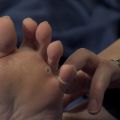What Dermatologists Say About the Causes, Types, and Risk Factors of Warts

Warts are rough, small, and grainy skin growths that occur mostly on fingers or hands. Often they appear as tiny black dots that possess clotted blood vessels.
Most of the time, these warts are harmless and may disappear after some time. However, many people find them bothersome and choose to remove them from a wart removal specialist.
In this article, we will discuss about what dermatologists say about the causes, types, identification, risk factors, and treatment options of warts.
What is the Main Cause of Warts?
• The main cause of warts is human papillomavirus (HPV), which is quite common with more than 150 strains present worldwide. However, only a few of them cause warts.
• The immune system of every person responds differently to the HPV virus.
• After getting exposed to the virus, it usually takes two to six months for your skin to develop warts.
• The HPV virus enters through small cuts on the skin. The outer skin layer through which the virus entered turns harder and thicker.
What are the Major Types of Warts?
• Common Warts
• Plantar Warts
• Flat Warts
• Mosaic Warts
How to Identify Common Warts?
• By their size: The size of common warts ranges from the size of the head of a pin to the size of a pea.
• By their texture: Their texture is hard which makes them scaly and rough in texture.
• By their location: Common warts are commonly found on the fingers, the skin surrounding the nails, back of the hands, and on your feet.
How can you Distinguish Plantar Warts?
• By their location: Plantar warts commonly occur on the soles and ankles of the feet.
• By their size: After some time, they rapidly develop and become quite large, which can cause pain and discomfort.
• By their growth pattern: The growth of plantar warts on the soles of the feet is inward due to the bodyweight applied while standing and walking.
How to Recognize Flat Warts?
• By their size: Flat warts are usually smaller (a few millimeters) and slightly raised warts.
• By their color: They appear light brown.
• By their location: Most commonly they are found on hands, face, and lower arms.
How Do You Know If You Have Mosaic Warts?
• By their size and color: Mosaic warts are generally the size of a pinhead and are white on color.
• By their location: They usually occur under the toes and on the feet. However, they may also cover and spread to larger areas of the skin.
• By their appearance: The appearance of mosaic warts is flatter as compared to plantar warts.
Who is at a Greater Risk of Developing Warts?
• People having a family history of warts.
• A person who works at a slaughterhouse or a butcher’s shop.
• A person who uses communal showers, for example at a swimming pool or a sports academy.
• People having a weak immune system.
• People who are already diagnosed with eczema.
How a Doctor can help in Treating Warts?
• Option 1: Using liquid nitrogen to freeze the skin wart.
• Option 2: Burning the skin wart.
• Option 3: By using a laser.
• Option 4: By using a chemical called cantharidin.
• Option 5: Surgical removal of skin warts.
• Option 6: By using topical medications.
When Should You See a Doctor?
If your skin warts keep on getting worse, then it may be a wise decision to consult a wart removal specialist. Keep in mind the contagious nature of warts, many dermatologists recommend trying various wart treatments because one single wart can give rise to many additional warts on your skin.